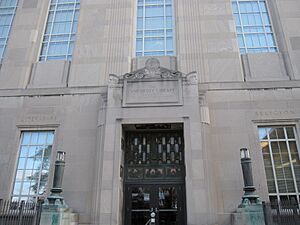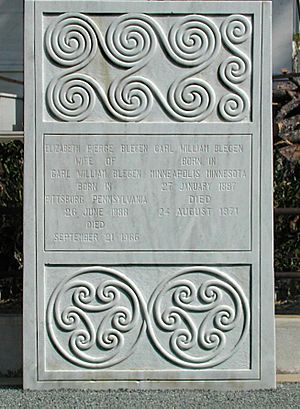Carl Blegen facts for kids
Carl William Blegen (born January 27, 1887 – died August 24, 1971) was an American archaeologist. He is well-known for his important work at ancient sites. These include Pylos in Greece and Troy in modern-day Turkey. He led the University of Cincinnati's excavations at Hisarlik, which is the site of ancient Troy, from 1932 to 1938.
Contents
Early Life and Education
Carl Blegen was born in Minneapolis, Minnesota. This was in 1887. He was the oldest of six children. His parents had moved from Lillehammer, Norway. Carl's father was a professor at Augsburg College. He was also a key figure in the Norwegian Lutheran Church in America.
Carl Blegen earned his first college degree from the University of Minnesota in 1904. He then started his advanced studies at Yale University in 1907.
Discovering Ancient Worlds

Carl Blegen became a fellow at the American School of Classical Studies at Athens in Greece. This was from 1911 to 1913. During this time, he worked on digs at places like Locris, Corinth, and Korakou.
During World War I, Blegen helped with relief efforts in Bulgaria and Macedonia. Greece honored him with the Saviors Order in 1919 for his work. After the war, he finished his Ph.D. at Yale University in 1920.
He then became the assistant director of the American School from 1920 to 1926. While there, he led excavations at Zygouries, Phlius, Prosymna, and Hymettos.
Professor and Major Excavations
In 1927, Blegen joined the University of Cincinnati. He was a professor of classical archaeology there from 1927 to 1957. His most famous excavations were at Troy. These digs took place between 1932 and 1938.
After Troy, he started digging at the Palace of Nestor in Pylos, Greece, in 1939. This work continued from 1952 to 1966. Many of the amazing things found during these digs are now kept in the Archaeological Museum of Chora. Carl Blegen retired in 1957.
Awards and Honors
Carl Blegen received many honorary degrees for his work. These came from universities in Oslo and Thessaloniki in 1951. He also received honors from the University of Oxford in 1957 and the University of Cincinnati in 1958.
More honors came in 1963 from Cambridge, the University of Athens, and Hebrew Union College. In 1965, Blegen was the first person to receive the Archaeological Institute of America's Gold Medal. This award is given for outstanding archaeological achievements.
Remembering Carl Blegen
The Carl Blegen Library is located at the University of Cincinnati. This library has a special exhibit called Discovering Carl Blegen. It shows pictures from his major digs in Troy and Pylos. It also covers his life and work at the university and abroad.
The Blegen Library at the American School of Classical Studies at Athens is also named after him. Blegen Hall at the University of Minnesota is named after his brother, Theodore C. Blegen.
Personal Life
Carl Blegen married Elizabeth Denny Pierce in 1924. She was also an archaeologist he met at the American School in Athens. They lived together in Athens with two friends, Ida Thallon and Bert Hodge Hill. They called themselves "the Family" or "the quartet."
Carl Blegen passed away in Athens, Greece, on August 24, 1971. He was 84 years old. He is buried in the Protestant section of the First Cemetery of Athens. His wife, Elizabeth Pierce Blegen, is buried there too. The graves of Ida Thallon and Bert Hodge Hill are also nearby. Carl W. Blegen left a large collection of his papers to the American School of Classical Studies at Athens.
Images for kids
See also
 In Spanish: Carl Blegen para niños
In Spanish: Carl Blegen para niños






